SpringBoot 集成 RabbitMQ ,如果只是简单的使用配置非常少,SpringBoot 提供了 spring-boot-starter-amqp 项目对消息各种支持。上一篇基于默认消息交换机(direct),下面对三种常用的交换机(Direct、Topic、Fanout)进行演示
[TOC]
RabbitMQ介绍
AMQP,即Advanced Message Queuing Protocol,高级消息队列协议,是应用层协议的一个开放标准,为面向消息的中间件设计。消息中间件主要用于组件之间的解耦,消息的发送者无需知道消息使用者的存在,反之亦然。AMQP 的主要特征是 面向消息、队列、路由(包括点对点和发布/订阅)、可靠性、安全。
RabbitMQ 是实现 AMQP(高级消息队列协议)的消息中间件的一种,最初起源于金融系统,用于在分布式系统中存储转发消息,在 易用性、扩展性、高可用性 等方面表现不俗。RabbitMQ 服务器端用 Erlang 语言 编写,支持多种客户端,如:Python、Ruby、.NET、Java、JMS、C、PHP、ActionScript、XMPP、STOMP等,支持AJAX。支持延迟队列(这是一个非常有用的功能)….
环境/版本一览:
- 开发工具:Intellij IDEA 2018.2.2
- springboot: 2.0.6.RELEASE
- jdk:1.8.0_171
- maven:3.3.9
- spring-boot-starter-amqp: 2.0.6.RELEASE
pom.xml
1 | <dependencies> |
application.yml
1 | spring: |
Direct
Direct 类型的交换器路由规则也很简单,它会把消息路由到那些 BindingKey 和 RoutingKey 完全匹配的队列中。
config
1 | package com.fatal.direct.config; |
sender
1 | package com.fatal.direct.sender; |
receiver
1 | package com.fatal.direct.receive; |
controller
1 | package com.fatal.direct.controller; |
显示
访问 http://localhost:8080/direct方法
控制台如下

Fanout
Fanout 就是我们熟悉的 广播模式或者发布/订阅模式,给 Fanout交换机 发送消息,绑定了这个交换机的所有队列都收到这个消息。
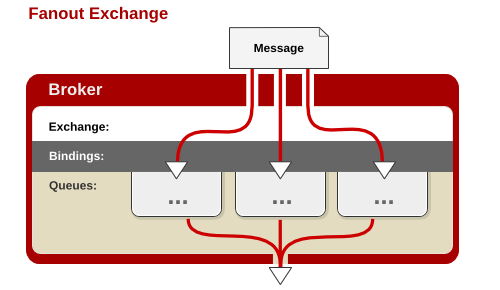
config
1 | package com.fatal.fanout.config; |
sender
1 | package com.fatal.fanout.sender; |
receiver
1 | package com.fatal.fanout.receiver; |
controller
1 | package com.fatal.fanout.controller; |
显示
访问 http://localhost:8080/fanout 方法
控制台如下

Topic
topic 是 RabbitMQ 中最灵活的一种方式,可以根据 routing_key 自由的绑定不同的队列
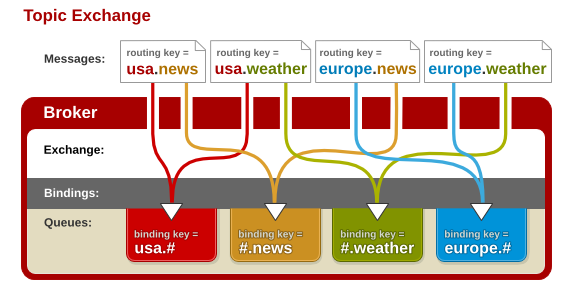
entity
注意:因为要通过网络传输发送给 RabbitMQ 服务器,所以需要实现序列化
1 | package com.fatal.topic.entity; |
config
1 | package com.fatal.topic.config; |
sender
1 | package com.fatal.topic.sender; |
receiver
1 | package com.fatal.topic.receiver; |
controller
1 | package com.fatal.topic.controller; |
显示
访问 http://localhost:8080/topic 方法
控制台如下

笔记
基础概念
Broker:简单来说就是消息队列服务器实体
Exchange:消息交换机,它指定消息按什么规则,路由到哪个队列
Queue:消息队列载体,每个消息都会被投入到一个或多个队列
Binding:绑定,它的作用就是把exchange和queue按照路由规则绑定起来,在绑定的时候一定会指定一个绑定键“Binding Key”
Routing Key:路由关键字,exchange根据这个关键字进行消息投递
vhost:虚拟主机,一个broker里可以开设多个vhost,用作不同用户的权限分离
producer:消息生产者,就是投递消息的程序
consumer:消息消费者,就是接受消息的程序
channel:消息通道,在客户端的每个连接里,可建立多个channel,每个channel代表一个会话任务
常见应用场景
- 邮箱发送:用户注册后投递消息到
rabbitmq中,由消息的消费方异步的发送邮件,提升系统响应速度 - 流量削峰:一般在 秒杀活动 中应用广泛,秒杀会因为流量过大,导致应用挂掉,为了解决这个问题,一般在应用前端加入消息队列。用于控制活动人数,将超过此一定阀值的订单直接丢弃。缓解短时间的高流量压垮应用。
- 订单超时:利用
rabbitmq的 延迟队列,可以很简单的实现 订单超时 的功能,比如用户在下单后30分钟未支付取消订单 - 还有更多应用场景就不一一列举了…..
怎么知道没有配置交换机的时候是使用Direct作为默认交换机呢?
点开 RabbitTemplate 的源码来看一下
它这里定义了一个常量 DEFAULT_EXCHANGE

然后,当我们使用 RabbitTemplate 发布消息的时候,如果我们没有指定交换机,那么调用的方法类似下面的 convertAndSend(String routingKey, final Object object) ,可以看出,它帮我们指定了默认的交换机了。

配置监听器订阅内容de三种方式
1、SimpleMessageListenerContainer + MessageListenerAdapter
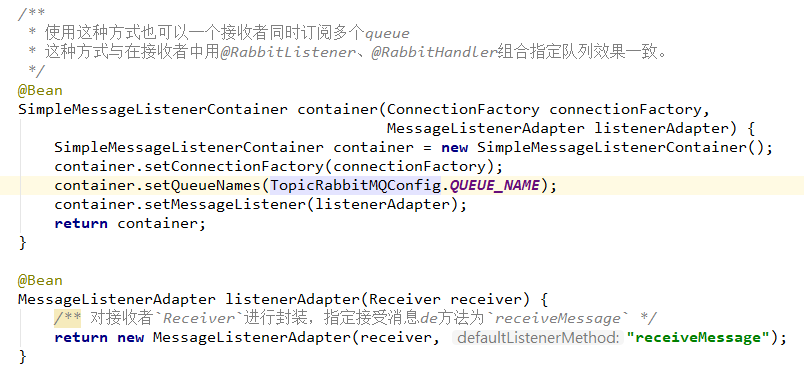
2、@RabbitListener + @RabbitHandler(后面提及的序列化将会对此方法展开描述)
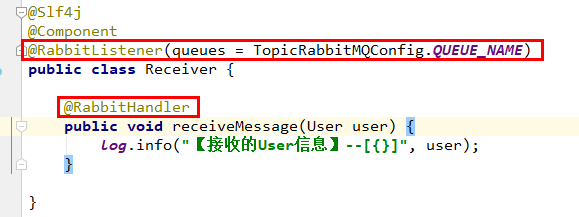
3、@RabbitListener
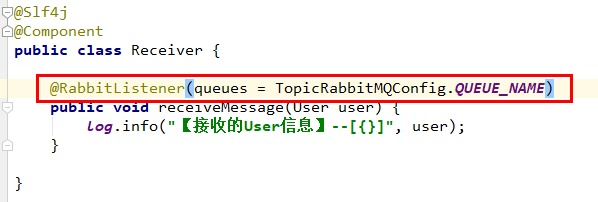
参考资料
一起来学SpringBoot | 第十二篇:初探RabbitMQ消息队列
总结
SpringBoot的知识已经有前辈在我们之前探索了。比较喜欢的博主有:唐亚峰 | Battcn、方志朋的专栏、程序猿DD、纯洁的微笑。对这门技术感兴趣的可以去他们的博客逛逛。谢谢他们的分享~~
以上文章是我用来学习的Demo,都是基于 SpringBoot2.x 版本。
源码地址: https://github.com/ynfatal/springboot2-learning/tree/master/chapter19_2